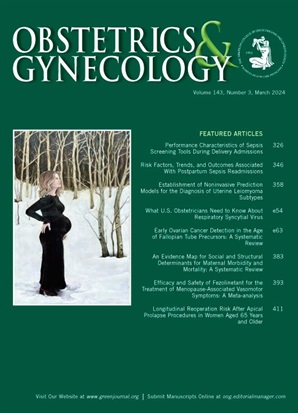Complications and Recurrence After Pelvic Exenteration for Gynecologic Malignancies: Survival Analysis From the COREPEX Study.
IF 4.7
2区 医学
Q1 OBSTETRICS & GYNECOLOGY
引用次数: 0
Abstract
OBJECTIVE To collect data from patients undergoing pelvic exenteration in recent clinical practice. The primary aim was 5-year disease-free survival. Secondary aims were 5-year overall survival, patterns of recurrence, identification of subgroups at higher risk of recurrence and death, survival associated with lymph node metastasis, and development of a prognostic score. METHODS This was a retrospective, multicenter, international study conducted in tertiary national gynecologic oncology referral centers. Inclusion criteria included cervical, vaginal, vulvar, or endometrial cancer; anterior or total pelvic exenteration performed between January 2005 and March 2023; curative or palliative intent; and with or without laterally extended endopelvic or pelvic resection. Patients were excluded if they underwent posterior pelvic exenteration only or if preoperative computed tomography (CT), positron emission tomography (PET)-CT, or PET was not performed. A prognostic score was developed that was based on multivariable analysis. RESULTS Eight hundred sixty-two patients were included. Surgical margins were tumor free in 676 (78.4%). In patients treated with curative intent, total pelvic exenteration, positive surgical margins, and presence of lymphovascular space invasion were independently associated with worse disease-free survival. Performance of lymphadenectomy was associated with better disease-free survival. Total pelvic exenteration, positive surgical margins, and presence of lymphovascular space invasion were factors independently associated with decreased overall survival. Performing pelvic exenteration at time of persistent (instead of recurrent) disease negatively affected overall survival. Prognostic score identified four risk groups with a 5-year disease-free survival of 43.7%, 24.9%, 22.2%, and 8.0% (P<.001). The 5-year overall survival in the four risk groups was 54.3%, 40.4%, 24.0%, and 4.3% (P<.001). The most frequent sites of recurrence were distant in 166 patients (32.1%). The 5-year disease-free survival and cancer-specific survival in patients with para-aortic lymph node metastasis were significantly worse compared with those in patients with pelvic-only metastatic nodes or with negative nodes (P=.002 and P<.001, respectively). CONCLUSION Independent factors associated with worse disease-free survival and overall survival and subgroups of patients at higher risk of recurrence and death were identified. A multivariable prognostic score was developed that can be used for patient counseling and surveillance strategies and for future prospective studies.妇科恶性肿瘤盆腔切除术后的并发症和复发:来自COREPEX研究的生存分析。
目的收集近期盆腔切除术患者的临床资料。主要目标是5年无病生存。次要目的是5年总生存率、复发模式、确定复发和死亡风险较高的亚组、与淋巴结转移相关的生存率,以及制定预后评分。方法:本研究是一项回顾性、多中心、国际性的研究,在三级国家妇科肿瘤转诊中心进行。纳入标准包括宫颈癌、阴道癌、外阴癌或子宫内膜癌;2005年1月至2023年3月期间进行的盆腔前切除术或全盆腔切除术;治疗或缓和的意图;并伴有或不伴有外侧扩展盆腔或骨盆切除术。如果患者只接受了骨盆后腔切除术,或者术前没有进行计算机断层扫描(CT),正电子发射断层扫描(PET)-CT或PET,则排除患者。在多变量分析的基础上建立了预后评分。结果共纳入862例患者。676例(78.4%)手术缘无肿瘤。在以治愈为目的治疗的患者中,全盆腔切除术、手术切缘阳性和淋巴血管间隙侵犯的存在与较差的无病生存率独立相关。淋巴结切除术与更好的无病生存相关。全盆腔切除、手术切缘阳性和淋巴血管间隙侵犯是降低总生存率的独立相关因素。在持续性疾病(而不是复发性疾病)时进行盆腔切除会对总生存率产生负面影响。预后评分确定了4个风险组,5年无病生存率分别为43.7%、24.9%、22.2%和8.0% (P< 0.001)。4个危险组的5年总生存率分别为54.3%、40.4%、24.0%和4.3% (P< 0.001)。166例(32.1%)复发部位为远处。主动脉旁淋巴结转移患者的5年无病生存率和肿瘤特异性生存率明显低于单纯盆腔淋巴结转移患者和阴性淋巴结转移患者(P= 0.002和P< 0.001)。结论:确定了与无病生存期和总生存期较差相关的独立因素以及复发和死亡风险较高的患者亚组。多变量预后评分可用于患者咨询和监测策略以及未来的前瞻性研究。
本文章由计算机程序翻译,如有差异,请以英文原文为准。
求助全文
约1分钟内获得全文
求助全文
来源期刊

Obstetrics and gynecology
医学-妇产科学
CiteScore
11.10
自引率
4.20%
发文量
867
审稿时长
1 months
期刊介绍:
"Obstetrics & Gynecology," affectionately known as "The Green Journal," is the official publication of the American College of Obstetricians and Gynecologists (ACOG). Since its inception in 1953, the journal has been dedicated to advancing the clinical practice of obstetrics and gynecology, as well as related fields. The journal's mission is to promote excellence in these areas by publishing a diverse range of articles that cover translational and clinical topics.
"Obstetrics & Gynecology" provides a platform for the dissemination of evidence-based research, clinical guidelines, and expert opinions that are essential for the continuous improvement of women's health care. The journal's content is designed to inform and educate obstetricians, gynecologists, and other healthcare professionals, ensuring that they stay abreast of the latest developments and best practices in their field.
 求助内容:
求助内容: 应助结果提醒方式:
应助结果提醒方式:


